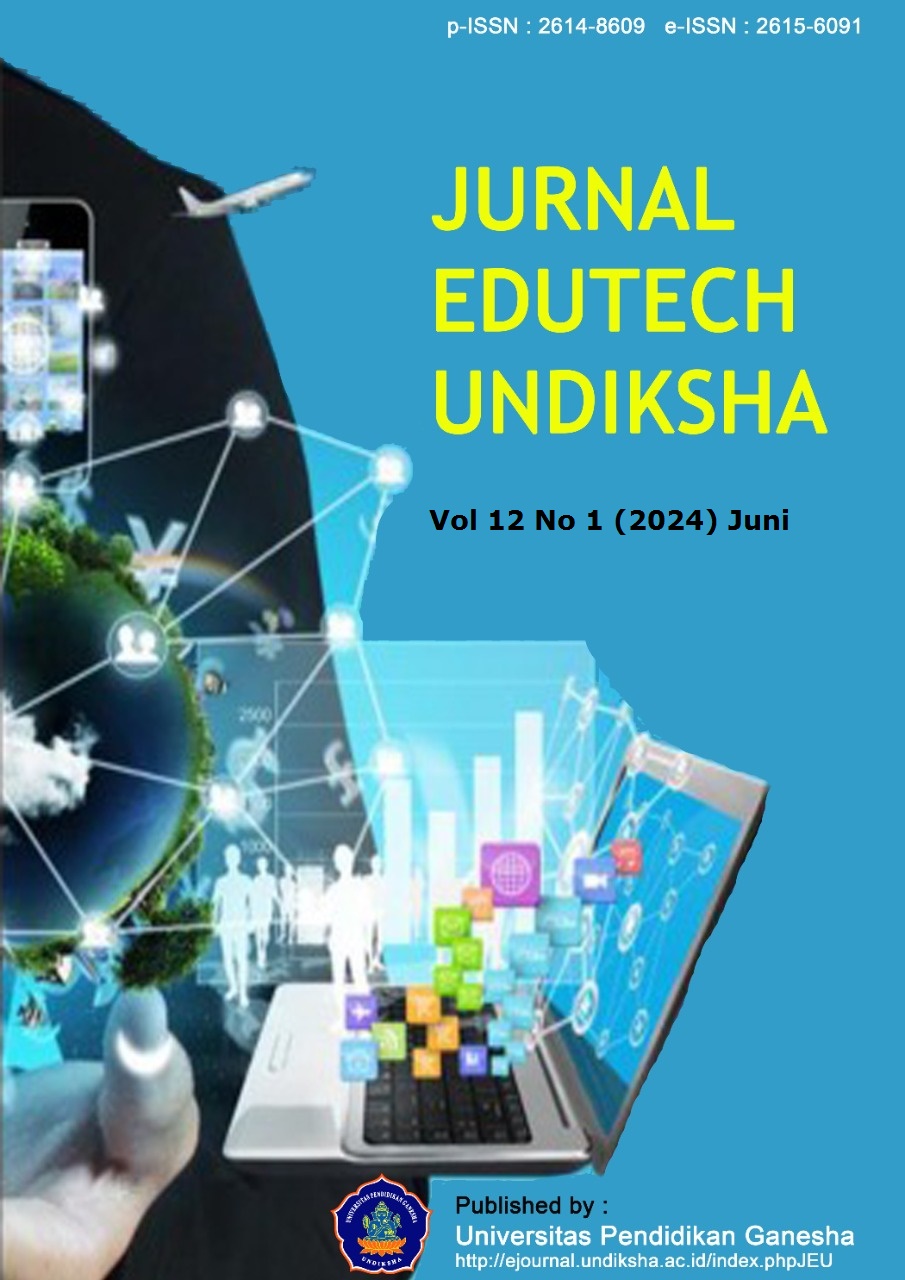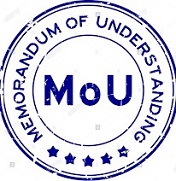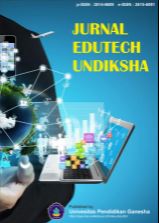Video Content of Menek Daha Ceremony (Ngeraja Sewala and Ngeraja Singha) as Audio Visual Learning Media
DOI:
https://doi.org/10.23887/jeu.v12i1.67546Keywords:
Content Video, Menek Daha Ceremony, Ngeraja Sewala, Ngeraja SinghaAbstract
Currently, with the development of technology, situational images related to insight and knowledge regarding commonly carried out religious ritual practices can be disseminated via digital platforms. This article aims to analyze the suitability of videos broadcast on YouTube with the content of the Ngeraja Sewala and Ngeraja Singha ceremonies in the Balinese Hindu community tradition as effective audio-visual learning media. This study uses a qualitative descriptive method by collecting data from videos on the YouTube platform conducting content analysis and evaluating the criteria for effective audio-visual learning media. Content analysis was carried out on the videos that had been collected. Continued with the process of processing data that has been collected and analyzed, through a qualitative approach and presenting it in the form of descriptions. The results of the study found that video content containing information about the Menek Daha ceremony (Ngeraja Sewala and Ngeraja Singha) which had been published via the YouTube platform was grouped into three types, namely: 1) Ordinary video documentation that is not intended as a medium for conveying more complete information to its viewers, 2) Documentary videos that include informative narrations where the sound narration and scenes in the video are out of sync, and 3) Video tutorials that make the source narrate direct and dominant in the video where between the narration and picture scenes are shown in sync.
References
Adzobu, N, Y. (2014). Design, Use and Evaluation of E-Learning Platforms: Experiences and Perspectives of a Practitioner from the Developing World Studying in the Developed World. Informatics, 1, 147–159. https://doi.org/10.3390/informatics1020147.
Agustini, K., Santyadiputra, G. S., & Sugihartini, N. (2020). Visualizing the stages of the educational research methodology into animation infographics for vocational students. Jurnal Pendidikan Vokasi, 9(3), 317–327. https://doi.org/10.21831/jpv.v9i3.22017.
Alkathiri, L. A. (2019). Students’ Perspectives towards Using Youtube in Improving EFL Learners’ Motivation to Speak. Journal of Education and Culture Studies, 3(1), 12. https://doi.org/10.22158/jecs.v3n1p12.
Almeida, F. (2020). Strategies To Perform A Mixed Method Study. European Journal of Education Studies, 7(1), 326–337. https://doi.org/10.5281/zenodo.1406214.
Angiolini, C., Ducato, R., Giannopoulou, A., & Schneider, G. (2020). Remote teaching during the emergency and beyond: Four open privacy and data protection issues of ‘platformised’education. Opinio Juris in Comparatione, 1, 45–47. https://doi.org/http://www.opiniojurisincomparatione.org/opinio/article/view/163/171.
Aqmarina Bella Agustin. (2019). Javanese Muslim Local Culture And Tradition In Islamic Perspective. Sunan Kalijaga International Journal on Islamic Educational Research (SKIJIER), 3(1), 15–24. https://doi.org/10.14421/skijier.2019.2019.31.02.
Artiningsih, N. W. J. (2020). Estetika Hindu Pada Pementasan Topeng Sidakarya Dalam Upacara Dewa Yadnya. Genta Hredaya: Media Informasi Ilmiah Jurusan Brahma Widya STAHN Mpu Kuturan Singaraja, 3(2). https://doi.org/10.55115/gentahredaya.v3i2.468.
Asmarani, N. N. O. (2020). Kurban Hewan dalam Upacara Yadnya: Membunuh atau Memuliakan? Jurnal Filsafat, 30(1), 46. https://doi.org/10.22146/jf.41794.
Assyifa, F. N., Rohita, & Nurfadilah. (2020). Pengaruh Video Pembelajaran Interaktif Mengenal Warna Terhadap Kemampuan Kognitif Anak. JIV-Jurnal Ilmiah Visi, 15(2), 137–146. https://doi.org/10.21009/jiv.1502.5.
Bakri, M., & Yusni, Y. (2021). Pemanfaatan youtube sebagai media pembelajaran menulis puisi. Silampari Bisa: Jurnal Penelitian Pendidikan Bahasa Indonesia, Daerah, Dan Asing, 4(1), 39–46. https://doi.org/10.31540/silamparibisa.v4i1.1183.
Barišić, K. D., Divjak, B., & Kirinić, V. (2019). Education systems as contextual factors in the technological pedagogical content knowledge framework. Journal of Information and Organizational Sciences, 43(2), 163–183. https://doi.org/10.31341/jios.43.2.3.
Binmahboob, T. (2020). YouTube as a Learning Tool to Improve Students’ Speaking Skills as Perceived by EFL Teachers in Secondary School. International Journal of Applied Linguistics and English Literature, 9(6), 13. https://doi.org/10.7575/aiac.ijalel.v.9n.6p.13.
Borch, J. (2019). Embracing Social Media to Engage Students and Teach Narrative Writing. In English Teaching Forum, 57(1), 26–31. https://eric.ed.gov/?id=EJ1212459.
Chizhik, E. W., & Chizhik, A. W. (2018). Using Activity Theory to Examine How Teachers’ Lesson Plans Meet Students’ Learning Needs. Teacher Educator, 53(1), 67–85. https://doi.org/10.1080/08878730.2017.1296913.
Devi, N. P. L., & Sudarma, I. K. (2023). Improving Student Balinese Language Learning Outcomes through Interactive Animated Video Based on a Contextual Method. Journal of Education Technology, 7(2), 351–360. https://doi.org/10.23887/jet.v7i2.64151.
Dung, P. T. T. (2021). The effects of Audiovisual Media on Students’ Listening Skills. International Journal of TESOL & Education, 1(1), 13–21. http://i-jte.org/index.php/journal/article/view/3.
Fajar Kurniawati, M. (2020). Dramaturgi Komunikasi Dolalak pada Perempuan, Pola Pengelolaan Pesan Ritual Penari Dolalak sebagai Kesenian Tradisional Sarana Media Komunikasi dalam Membantu Pemerintah pada Program Pembangunan di Purworejo Jawa Tengah. In Annual Conference of Communication, Media and Culture (ACCOMAC), 2(1), 20–26. http://proceeding.unisba.ac.id/index.php/accomac/article/view/1625.
Fathurrosi, F. (2023). Simbol Masyarakat Melayu Kendawangan Dalam Ritual Tradisi Tijak Tanah (Analisis Sosio Dan Nilai Pendidikan Islam). Indonesian Journal of Social Science Education (IJSSE), 5(1), 80. https://doi.org/10.29300/ijsse.v5i1.10736.
Fauzi, Hilmi, A. (2017). Utilization of Audio Visual Media to Improve Student Learning Result in IPS Learning. International Journal Pedagogy of Social Studies, 2(1), 88. https://doi.org/10.17509/ijposs.v2i1.8666.
Fikri, M., Zaki Ananda, M., Faizah, N., Rahmani, R., & Adelia Elian, S. (2021). Kendala Dalam Pembelajaran Jarak Jauh Di Masa Pandemi Covid-19: Sebuah Kajian Kritis. Jurnal Education and Development, 9(1), 144–150. https://doi.org/10.37081/ed.v9i1.2290.
Friskawati, G. F., & Supriadi, D. (2020). Video analysis with youtube platform for physical education, health, and recreation students’s higher order thinking skills (HOTs. Journal Sport Area, 7(1), 96–103. https://doi.org/10.25299/sportarea.2022.vol7(1).7737.
Herawann, K. D., & Sudarsana, I. K. (2017). Relevansi Nilai Pendidikan Karakter. Jurnal Penjaminan Mutu Lembaga Penjaminan Mutu Institut Hindu Dharma Negeri Denpasar, 3(2), 223–236. http://ojs.uhnsugriwa.ac.id/index.php/JPM/article/view/1320.
Hermanto, Y. B., & Srimulyani, V. A. (2021). The Challenges of Online Learning During the Covid-19 Pandemic. Jurnal Pendidikan Dan Pengajaran, 8(2), 1. https://doi.org/10.37762/jgmds.8-2.215.
Kamid, Marzal, J., Ramadhanti, A., Rohati, Simamora, N. N., & Iqbal, M. (2021). Study of Ethno-mathematics and Vygotsky’s Constructivism on Jambi Traditional Marriages. Educational Sciences: Theory and Practice, 21(4), 123–137. https://doi.org/10.12738/jestp.2021.3.008.
Kerr-Sims, S., & Baker, D. M. A. (2021). Faculty perceptions of teaching online during the COVID-19 university transition of courses to an online format. Journal of Teaching and Learning with Technology, 10, 337–353. https://doi.org.
Khusniati, M., Parmin, & Sudarmin. (2017). Local wisdom-based science learning model through reconstruction of indigenous science to improve student’s conservationist character. Journal of Turkish Science Education, 14(3), 16–23. https://doi.org/https://doi.org/10.12973/tused.10202a.
Kissi, L., & Dreesmann, D. (2018). Plant visibility through mobile learning? Implementation and evaluation of an interactive Flower Hunt in a botanic garden. Journal of Biological Education, 52(4), 344–363. https://doi.org/10.1080/00219266.2017.1385506.
Kolesnikov, A., Zhai, X., & Beyer, L. (2019). Revisiting self-supervised visual representation learning. Proceedings of the IEEE Computer Society Conference on Computer Vision and Pattern Recognition, 2019-June, 1920–1929. https://doi.org/10.1109/CVPR.2019.00202.
Liu, Y. (2023). TikTok’s Influence on Education. Journal of Education, Humanities and Social Sciences, 8, 277–280. https://doi.org/10.54097/ehss.v8i.4261.
Mardiani, D. P. (2021). Pengaruh Peran Orang Tua Terhadap Motivasi dan Kedisiplinan Belajar Anak Sebagai Dampak Wabah Covid-19. Jurnal Paradigma, 11(April), 109–144. https://www.staimmgt.ac.id/wp-content/uploads/2021/06/7.-PENGARUH-PERAN-ORANG-TUA-TERHADAP-MOTIVASI-DAN-KEDISIPLINAN-BELAJAR.pdf.
Mohd Rosmadi, I., & Mohamed Isa, Z. (2019). Essential Elements of Children’S Story Books in Islamic Pedagogy Based on Al-Quran To Cultivate Prosocial Behaviour Among Preschool Children. International Journal of Education, Psychology and Counseling, 29, 204–214. https://doi.org/10.35631/ijepc.4310017.
Morrar, R., Arman, H., & Mousa, S. (2017). The fourth industrial revolution (Industry 4.0): A social innovation perspective. Technology Innovation Management Review, 7(11), 12–20. https://timreview.ca/sites/default/files/Issue_PDF/TIMReview_November2017.pdf#page=12.
Munawaroh, S. (2019). Teaching the narrative texts using animation video: raising students’ skills on reading comprehension. Utamax : Journal of Ultimate Research and Trends in Education, 1(1), 18–22. https://doi.org/10.31849/utamax.v1i1.2791.
Munawwarah, R. Al. (2019). Sparkol videoscribe sebagai media pembelajaran. Jurnal Inspiratif Pendidikan, 8(2), 430–437. https://doi.org/10.24252/ip.v8i2.12412.
Nomleni, F. T., & Manu, T. S. N. (2018). Pengembangan Media Audio Visual dan Alat Peraga dalam Meningkatkan Pemahaman Konsep dan Pemecahan Masalah. Scholaria: Jurnal Pendidikan Dan Kebudayaan, 8(3), 219–230. https://doi.org/10.24246/j.js.2018.v8.i3.p219-230.
Ozdamli, F., & Ozdal, H. (2018). Developing an instructional design for the design of infographics and the evaluation of infographic usage in teaching based on teacher and student opinions. Eurasia Journal of Mathematics, Science and Technology Education, 14(4), 1197–1219. https://doi.org/10.29333/ejmste/81868.
Parmajaya, I. P. G. (2016). Peningkatan Kualitas Dan Mutu Pendidikan Agama Hindu Melalui Pemahaman Taksonomi Tri Kaya Parisudha. Jurnal Penjaminan Mutu, 2(2), 31. https://doi.org/10.25078/jpm.v2i2.70.
Perbowosari, H. (2018). Parenting Models In Building The Religious Characters of Children. Vidyottama Sanatana: International Journal of Hindu Science and Religious Studies, 2(1), 39. https://doi.org/10.25078/ijhsrs.v2i1.512.
Prasetya, R. E. (2021). Effectiveness of Teaching English for Specific Purposes in LMS Moodle: Lecturers’ Perspective. Journal of English Language Teaching and Linguistics, 6(1), 93. https://doi.org/10.21462/jeltl.v6i1.498.
Pratiwi, K. D. (2016). Students ’ difficulties in writing English : A study at the third semester students of English education program At University of Bengkulu. E Journal Universitas Bengkulu, 1(2), 1–13. https://doi.org/10.29300/ling.v3i1.106.
Priantini, D. A. M. M. O. (2020). The Development of Teaching Video Media Based on Tri Kaya Parisudha in Educational Psychology Courses. Dewa Ayu Made Manu Okta Priantini, 4(4), 448–455. https://doi.org/10.23887/jet.v4i4.29608.
Prijanto, J. H., & Kock, F. De. (2021). Peran Guru Dalam Upaya Meningkatkan Keaktifan Siswa Dengan Menerapkan Metode Tanya Jawab Pada Pembelajaran Online. Scholaria: Jurnal Pendidikan Dan Kebudayaan, 11(3), 238–251. https://ejournal.uksw.edu/scholaria/article/view/4318.
Purwati, P. (2021). Implementasi Media Video Animasi Interaktif Secara Daring Untuk Meningkatkan Hasil Belajar Dan Keaktifan Siswa Kelas IV SDN Tulung 03 Pada Tema 8 Semester 2 Tahun Pelajaran 2020/2021. Educatif Journal of Education Research, 3(2), 124–134. https://doi.org/10.36654/educatif.v3i2.76.
Rejekiningsih, T., Budiarto, M. K., & Sudiyanto, S. (2021). Pengembangan Multimedia Interaktif Berbasis Potensi Lokal Untuk Pembelajaran Prakarya Dan Kewirausahaan Di SMA. Kwangsan: Jurnal Teknologi Pendidikan, 9(2), 167. https://doi.org/10.31800/jtp.kw.v9n2.p167--185.
Renawati, P. W. (2019). Implementasi Upacara Manusa Yadnya Dalam Naskah Dharma Kahuripan (Perspektif Teologi Hindu). Mudra Jurnal Seni Budaya, 34(3), 372–384. https://doi.org/10.31091/mudra.v34i3.796.
Rohbiah, T. S. (2020). An analysis of Semantic changes of English lexical borrowings in Indonesia Tourism field. Loquen: English Studies Journal, 13(1), 40. https://doi.org/10.32678/loquen.v13i1.2554.
Rosmala, D., Hidayati, A. N., & Abdullah, F. (2021). Early Language Development ofaChildwithExpressive Language Disorder:A Parents’ Narration. J-SHMIC: Journal of English for Academic, 8(1), 86–96. https://doi.org/10.25299/jshmic.2021.vol8(1).6305.
Savas, P. (2012). Use of Digital Video Recording in the Preparation Stage of Pre-Service Foreign Language Teachers’ Micro-Teachings. International Journal on New Trends in Education and Their Implications, 3(3), 107–116. http://ijonte.org/FileUpload/ks63207/File/ijonte_2012.3._complete.pdf#page=114.
Setiawan, N. C. E., Dasna, I. W., & Muchson, M. (2020). Pengembangan Digital Flipbook untuk Menfasilitasi Kebutuhan Belajar Multiple Representation pada Materi Sel Volta. Hydrogen: Jurnal Kependidikan Kimia, 8(2), 107. https://doi.org/10.33394/hjkk.v8i2.3194.
Sproston, K., Sedgewick, F., & Crane, L. (2017). Autistic girls and school exclusion: Perspectives of students and their parents. Autism and Developmental Language Impairments, 2. https://doi.org/10.1177/2396941517706172.
Suadnyana, I. B. P. E. (2020). Kain Tenun Cagcag pada Upacara Manusa Yadnya di Kelurahan Sangkaragung Kabupaten Jembrana. Jnanasiddhanta: Jurnal Teologi Hindu, 2(1), 51–60. https://doi.org/10.55115/jnana.v2i1.820.
Suastika, I. N. (2021). The Process and Meaning of the Manusa Yadnya Ceremony for the Hindu Bali Community. International Journal of Social Science and Business, 5(1), 155–160. https://doi.org/10.23887/ijssb.v5i1.29279.
Sudiada, I. P. A. (2021). Pelaksanaan Manusa Yadnya dalam Upacara Melasti pada Bayi Kembar di Desa Pakraman Banyuseri, Kecamatan Banjar, Kabupaten Buleleng, Bali. Jurnal Widya Sastra Pendidikan Agama Hindu, 4(1), 37–45. https://doi.org/10.36663/wspah.v4i1.209.
Supeni, S., Hakim, L., & Jumintono. (2019). Strengthening Character Education of Early Childhood through Javanese Traditional Game Dakon. International Journal of Recent Technology and Engineering, 7(6S2), 243–249. https://www.atlantis-press.com/proceedings/ijcah-20/125947406.
Temaja, I. G. B. W. B. (2021). Pentingnya makna dan nilai budaya konsep kaja kangin (utara timur) di Bali pada anak. Widya Kumara Jurnal Pendidikan Anak Usia Dini, 2(2), 189–198. https://doi.org/10.55115/widyakumara.v2i2.1566.
Thanh, C. P., Phuong, A. L., Tien, M. P., Loc, P. H., Huy, T. L., Thanh, T. N., Dung, T. N., & Hung, V. T. (2021). Identifying and Applying the Information Technology Competence Framework in an Online Teaching Environment. In Handbook of Research on Barriers for Teaching 21st-Century Competencies and the Impact of Digitalization, 356–382. https://doi.org/10.4018/978-1-7998-6967-2.ch019.
Torres-Gastelú, C. A., & Kiss, G. (2016). Perceptions of students towards ICT competencies at the University. Informatics in Education, 15(2), 319–338. https://doi.org/10.15388/infedu.2016.16.
Vallori, A. B. (2014). Meaningful Learning in Practice. Journal of Education and Human Development, 3(4), 199–209. https://doi.org/10.15640/jehd.v3n4a18.
Vartiainen, H., Pöllänen, S., & Liljeström, A. (2016). Designing Connected Learning: Emerging learning systems in a craft teacher education course. Design And, 21(2), 32–40. https://ojs.lboro.ac.uk/DATE/article/download/2115/2281.
Wartayasa, I. K. (2018). Pelaksanaan Upacara Yadnya Sebagai Implementasi Peningkatan dan Pengamalan Nilai Ajaran Agama Hindu. Kamaya: Jurnal Ilmu Agama, 1(3), 186–199. https://jayapanguspress.penerbit.org/index.php/kamaya/article/view/79.
Widodo, A. (2020). Nilai Budaya Ritual Perang Topat Sebagai Sumber Pembelajaran IPS Berbasis Kearifan Lokal di Sekolah Dasar. Gulawentah:Jurnal Studi Sosial, 5(1), 1. https://doi.org/10.25273/gulawentah.v5i1.6359.
Wiriawan, I. G. N. (2020). Upacara Manusa Yadnya Dalam Lontar Smarareka. Kalangwan Jurnal Pendidikan Agama, Bahasa Dan Sastra, 10(2), 93–100. https://doi.org/10.25078/kalangwan.v10i2.1493.
Yasa, I. N. K. (2024). Tradisi Upacara Tiga Bulan Menurut Agama Hindu Di Bali: Three Months Ceremony Tradition According to Hindu Religion in Bali. Nirwasita: Jurnal Pendidikan Sejarah Dan Ilmu Sosial, 5(1), 75–87. https://doi.org/10.59672/nirwasita.v5i1.3623.
Yunita, E., & Untari, R. S. (2018). Development of a Mind Map-Based Module Using a Project Based Learning (PjBL) Model to Improve Learning Achievement in Students of the X Multimedia Computer and Informatics Engineering Expertise Program at Vocational Schools. JICTE (Journal of Information and Computer Technology Education, 2(1), 18. https://doi.org/10.21070/jicte.v2i1.600.
Downloads
Published
How to Cite
Issue
Section
License
Copyright (c) 2023 I Wayan Sudiarta, Dewa Gede Hendra Divayana, I Gde Wawan Sudatha

This work is licensed under a Creative Commons Attribution-ShareAlike 4.0 International License.
Authors who publish with the Jurnal EDUTECH Undiksha agree to the following terms:
- Authors retain copyright and grant the journal the right of first publication with the work simultaneously licensed under a Creative Commons Attribution License (CC BY-SA 4.0) that allows others to share the work with an acknowledgment of the work's authorship and initial publication in this journal.
- Authors are able to enter into separate, additional contractual arrangements for the non-exclusive distribution of the journal's published version of the work (e.g., post it to an institutional repository or publish it in a book), with an acknowledgment of its initial publication in this journal.
- Authors are permitted and encouraged to post their work online (e.g., in institutional repositories or on their website) prior to and during the submission process, as it can lead to productive exchanges, as well as earlier and greater citation of published work. (See The Effect of Open Access)














